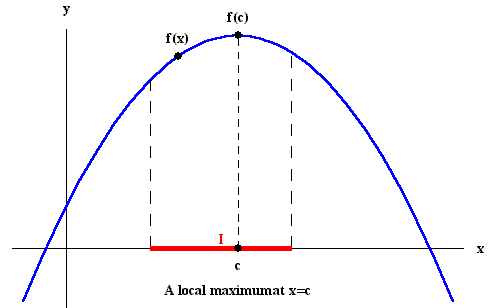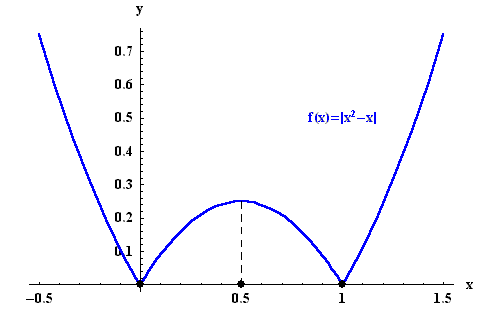 Critical Points
Critical Points  Critical Points
Critical Points We will discuss the occurrence of local maxima and local minima of a function. In fact, these points are crucial to many questions related to optimization problems. We will discuss these problems in later pages.
Definition. A function f(x) is said to have a local
maximum at c iff there exists an interval I around c such
that
 |
Using the definition of the derivative, we can easily show that:
|
If f(x) has a local extremum at c, then either
These points are called critical points. |
Example. Consider the function f(x) = x3. Then f'(0) = 0 but 0 is not a local extremum. Indeed, if x < 0, then f(x) < f(0) and if x > 0, then f(x) > f(0).
 |
Therefore the conditions
Example. Let us find the critical points of


Let c be a critical point for f(x). Assume that there exists
an interval I around c, that is c is an interior point of
I, such that f(x) is increasing to the left of c and
decreasing to the right, then c is a local maximum. This
implies that if
![]() for
for ![]() (x close to c),
and
(x close to c),
and
![]() for
for ![]() (x close to c), then c is
a local maximum. Note that similarly if
(x close to c), then c is
a local maximum. Note that similarly if
![]() for
for ![]() (x close to c), and
(x close to c), and
![]() for
for ![]() (x close to c), then c is a local minimum.
(x close to c), then c is a local minimum.
So we have the following result:
| First Derivative Test. If c is a critical point for f(x), such that f '(x) changes its sign as x crosses from the left to the right of c, then c is a local extremum. |
Example. Find the local extrema of




 |
Let c be a critical point for f(x) such that f'(c) =0.
|
Example. Find the local extrema of
 |
Exercise 1. Find the local extrema of
Exercise 2. Find the local extrema of
Do you need more help? Please post your question on our
S.O.S. Mathematics CyberBoard.
![]()
![]()
 S.O.S MATHematics home page
S.O.S MATHematics home page
Helmut Knaust
Contact us
Math Medics, LLC. - P.O. Box 12395 - El Paso TX 79913 - USA
users online during the last hour